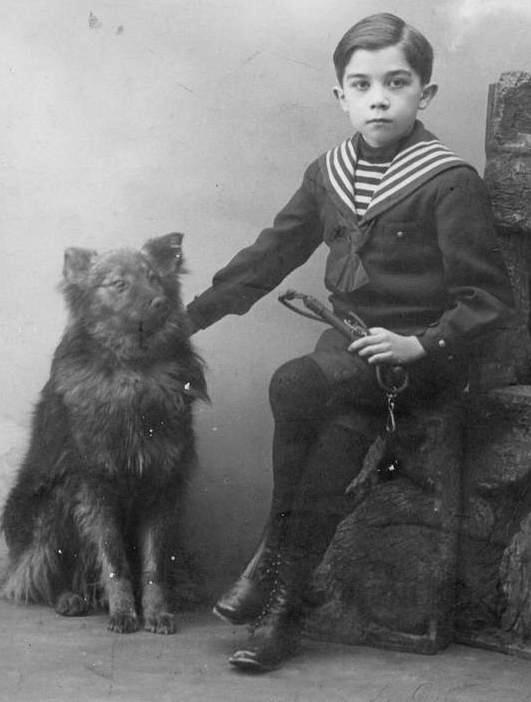
Belgian Sailors Suits: Garments

Figure 1.--This Belgian boy and his keeshond dog was photographed about 1905-10 . He has a blouse with four stripes. He has a striped dickey, a style popular in France. His sailor scrafe is tightly tied. He has a knee pants suit. The boy wears long stockings, probably because the portrait was taken durinthe fall or winter.
|
|
The sailor suit gaments were the same as worn throughout Europe. We do not yet have enough Belgian images to know much specific styles and garments. As far as we know, Belgian styles were quite similar to those worn We do not know of any specific Belgian styles at this time. The sailor caps commonly worn to those worn elsewhere in Europe. Flat top caps with streamers were popular in the early 1900s. Most boys who wore sailor suits would have a matching hat or cap. Many boys wore their streamers to the side for photographs, but we do not think this is how they normally wore their caps. Smaller boys wore broad-brimmed hats with streamers. Older boys wore caps more like the ones wore by sailors. After World War I, boys in the 1920s were less likely to wear sailor caps with their suits. Many Belgian boys wore standard middy blouses. The boy hear wears a jacket with souble button rows, but held closed by a kind of tab on the top buttons. The standard three white stripes were common in the detailing as was a nautical motif on the dicky. Most boys wore knee pants with their sailor suits in the early 20th century. Some boys wore bloomer knickers. After World War I (1914-18), short pants became more popular. We see long pants suits , often for formal occassions.
Caps
The sailor caps commonly worn to those worn elsewhere in Europe. Flat top caps with streamers were popular in the early 1900s. Most boys who wore sailor suits would have a matching hat or cap. Many boys wore their streamers to the side for photographs, but we do not think this is how they normally wore their caps. Smaller boys wore broad-brimmed hats with streamers. Older boys wore caps more like the ones wore by sailors. After World War I, boys in the 1920s were less likely to wear sailor caps with their suits.
Sailor outfirs were very popular in Belgium. And we note Belgian boys wearing many different styles of sailor blouses. There were no destinctive Belgian styles. The only distinctive feature on some Belgiuan sailor blouses is the sleeve rank feature. Not all Belgian blouses had them, but some did. Otherwise we see suits that look like French and Dutch suits. Wethink French styls sere the predominate influence, but this needs to be confirmed. We do not know yet if there wre differences with the stles worn by the Flemish and Waloons. Many Belgian boys wore standard sailor blouses. The blouses had sailor collars with a V-front and back flap. There were other styles, but this was the most common detailing style. The boy on the previous page wears a jacket with double button rows, but held closed by a kind of tab on the top buttons. Stripes were common in the detailing. Three stripes were common, but there were a variety of other stripe arrangements. We also see stripes and nautical motifs on the dicky. Three stripes were traditional, especially on British and American blouses, but on the Continent there was greater variety. The blouses were commonly worn wih a scafe. The detailing on the V-front collar was continued on the back flaThe boy here has a blouse with four stripes (figure 1). He has a striped dickey, a style popular in France. His sailor scrafe is tightly tied. We do not se scarves with a white cord like German blouses. The blouses as the name suggest sometimes blouses. These were pull-over garments,. Others did not blouse but hung loose. we also see button-pn blouses which acted to hold up the pants. Other sailor blouses buttoned` up the front. Most sailor suits were navy blue or white or sometimes a white blouse and navy pants. There were other color, but they were not nearly as common as the navy blue and white outfits.
Pants
Most boys wore knee pants with their sailor suits in the early 20th century. Some boys wore bloomer knickers. After World War I (1914-18), short pants became more popular. We see long pants suits , often for formal occassions.
Hosiery
We see boys weating different types of hosiery with their sailor suits. This depended on both seasonality and formality as well ss changing fashion trends over time. The boy here wears long stockings, probably because the portrait was taken durin the fall or winter (figure 1).
HBC

Sailor Suit HBC Country Related Pages:
[Return to the Main Belgian sailor suit page]
[American]
[English]
[French]
[German]
[Italian]
Other Related HBC Pages:
[Sailor suits]
[Kilts]
[Smocks]
[Pinafores]
[Sailor Hats]
[Blouses]
[Ring Bearers]
[Long hair]
[Ringlet curls]
[Hair bows]
[Bangs]
[Collars]
[Bows]
Navigate the Boys' Historical Clothing Web Site:
[Introduction]
[Activities]
[Biographies]
[Chronology]
[Countries]
[Garments]
[Bibliographies]
[Contributions]
[FAQs]
[French glossary]
[Dutch glossary]
[Images]
[Links]
[Registration]
[Tools]
[Boys' Clothing Home]
Created: 11:58 PM 5/29/2009
Last updated: 2:05 PM 11/10/2014



